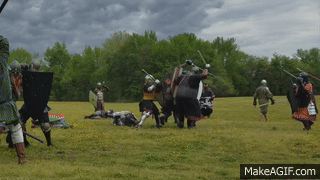Filling the Gap
We fought with the Tuchux and the other non-Aethelmearc groups. Anglesey and Galatia brought with us 5 spears (four with 6-30 years experience), a veteran pole arm, a veteran shield, and two new shieldmen (one with ~18 months experience, the other at her second event). We also had a newish archer.
Now it shouldn't be too difficult to figure out what our capabilities are. If we could find a static place in the battle we were deadly, and had just enough back up to keep the bad guys off os us. However, if a fresh unit wished to dedicate a charge at us, there was nothing we could do to stop it.
As a result I wanted us to form up behind a large unit near a gap. The larger unit would protect us, but the gap would be a nice place to shoot out and find some good killing opportunities.
When we initially lined up, the Tuchux were to our right, and a large unit (I believe it was a combination of Cloven Shield, the Mid, and maybe another group) formed up on our left. Before the battle began, our guys were meandering about on the front line between the two groups. It was a struggle to motivate them off of the front line as I had to make it clear that I didn't want the two main units to think that we were going to plug that gap. They needed to know that there was a hole there, because we sure as hell were not going to stop a shield wall coming at us. Had we moved forward with the main units and saw such a unit come at us, we would have had no choice but to pull out, leaving a hole that they weren't expecting, and possibly leading to a bad field position.
As each battle began and the two sides engaged, we pretty much pushed into that gap looking to exploit a flank or a bad position for the enemy. Last year I saw this many times, however they seemed better prepared this year. We always seemed to be up against some of the best spears that Aethelmearc had to offer and if I remember correctly, the results were fairly close each time. We never really crushed through that gap, but we never really lost it either.
Adapting to a Fallen Flank
I don't consider myself to be a great field commander. I'm pretty good if I know what to do ahead of time, but if I'm given a situation that I'm unfamiliar with, I don't come up with ideas quickly. A fallen flank, however, if a scenario that I've seen plenty of times and one that I think I'm pretty good at adapting to.
Consider the following diagram:
Here you can see that our left flank is collapsing. This actually happened several times that weekend, and I'm not really sure why. I'm a strong proponent of controlling the flanks before anything else. Maybe the scenario was set up intentionally (it was a practice, after all). Maybe they just couldn't muster up enough strength to hold that position. Maybe it was bad tactics. Either way, our flank kept dropping.
Now I'm not in charge of that flank, but I do have influence over my own group. In this situation, we really only have four options:
1) Keep fighting as usual - this is the worst of the four as it would lead us to getting surrounded and dying quickly.
2) Make a hard push through the people we are facing (we did this in a similar scenario at last Pennsic's field battle). This is generally the best option IF we can overpower our opponent and come out the other side with minimal casualties. This was not the case.
3) Pull out and move left - this attempts to reposition our unit to stop or slow the collapsing flank.
4) Pull out and move right - this is ideally done either when the left flank is a lost cause, or if there is a small unit to the right that can be quickly taken out once we've moved over there. In this case its a tradeoff; give up the left flank for a good position on the right.
In each case at the war practice we did not overpower the fighters in our position, and there was no opportunity to our right (we would have been running into the backs of Tuchux), so we pulled out and moved left to slow that flank.
Slowing a Fallen Flank
I once said, "If you are going to die, then die slowly," to which my friend laughed as if what I was saying was ridiculous. Not at all. You don't do anyone any good charging into a death trap only to take yourself out of the fight. If they have you beat, retreat, draw them our of the fight, or stall.
The video below is a good example. At the 1:00 mark you can see our left flank completely fall, but then slow a bit. This was the point where we redeployed to cover that flank. By 2:00 you can see that the enter battle has rotated 180 degrees with our left falling, but the Tuchux pushing through on our right.
I first appear on the left half of the screen at 2:41. You can see me and a small group of fighters stalling the fight for about 2 minutes. We almost won the battle by giving the Tuchux some time to finish up their fight. We actually ended up doing a full lap around the battle field trying to slow this group up, getting a kill here and a kill there along the way.









